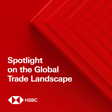Become a Creator today!Start creating today - Share your story with the world!
Start for free
00:00:00
00:00:01

HSBC Sibos spotlight series - Revolutionising the customer experience in a fragmented world
Vinay Mendonca, Chief Growth Officer, Global Trade && Receivables Finance, HSBC and Gert Sylvest, Co-Founder, GM of Small Business & Fintech Product, Tradeshift join Eleanor Hill (TMI) for an informal discussion around driving supply chain resilience through embedded finance.
Vinay and Gert identify the challenges that corporates are facing in the supply chain space and consider the ways in which treasury teams can leverage ecommerce to homogenise the trade finance funding gap. Furthermore, find out more about a recent collaboration between HSBC and Tradeshift which is helping to produce embedded finance solutions to facilitate supply chain resilience for corporates.
Hosted on Acast. See acast.com/privacy for more information.
Transcript
Introduction to HSBC Global Viewpoint Podcast
00:00:02
Speaker
Welcome to HSBC Global Viewpoint, the podcast series that brings together business leaders and industry experts to explore the latest global insights, trends, and opportunities.
00:00:13
Speaker
Make sure you're subscribed to stay up to date with new episodes.
00:00:16
Speaker
Thanks for listening.
00:00:17
Speaker
And now onto today's show.
Collaboration with HSBC and Cyboss 2023 Overview
00:00:23
Speaker
Welcome to TMI's TreasuryCast and HSBC's Cyboss Spotlight.
00:00:27
Speaker
I'm Eleanor Hill, Editor of TMI, and I'm delighted to be working with HSBC to bring you an in-depth look at the events from this year's Cyboss.
00:00:36
Speaker
Throughout this series, we will explore the critical topics on the Cyboss 2023 agenda that will shape our industry in the next decade, including sustainability, digital acceleration and technological innovation.
00:00:50
Speaker
We'll examine the opportunities and the challenges in the areas of payments, securities, cash management and trade.
Introduction to Trade and Embedded Finance Discussion
00:00:57
Speaker
So in the studio today, we have Vinay Mendonsov, who is Chief Growth Officer, Global Trade and Receivables Finance from HSBC.
00:01:06
Speaker
And he's joined by Gert Silvest, who is Co-Founder, GM of Small Business and Fintech Product at TradeShift.
00:01:13
Speaker
So welcome, both of you.
00:01:14
Speaker
It's great to have you here.
00:01:15
Speaker
And Vinay, I know it's not your first time.
00:01:17
Speaker
It's been about 12 months since we last spoke, and there's been so much going on in the world in that time.
00:01:24
Speaker
So we've got an awful lot to talk about in terms of what's happened in the trade space and what's going to be happening around embedded finance, which is going to be our topic for today.
Building Supply Chain Resiliency
00:01:33
Speaker
So let's kick off maybe with a look at the challenges that corporates are facing and how their needs are evolving, particularly around trade, given, like we say, all of these things that are going on in the wider world.
00:01:46
Speaker
Vinay, maybe you can start us off then.
00:01:48
Speaker
Sure, thanks.
00:01:49
Speaker
And hi, Eleanor, and hi, everyone.
00:01:50
Speaker
It's great to be back again.
00:01:52
Speaker
In terms of challenges and what clients have been telling us over the last 12 months, I think one of the key trends remains quite consistent from what we saw last year, which is really around building supply chain resiliency in the face of the various dislocations that clients have seen
00:02:12
Speaker
for themselves, for their suppliers and for their customers over the last three or four years on the back of the pandemic, the geopolitical tensions and the like, right?
00:02:21
Speaker
So I think building that supply chain resiliency is critical.
00:02:25
Speaker
And what we have seen customers do in that regard is work towards more agile supply chains where they can diversify their supplier bases and
00:02:34
Speaker
and also then support those suppliers through liquidity, through trade terms that make it easier for them to procure materials and continue to kind of fuel the overall supply chain.
00:02:45
Speaker
So one trend continues to be around supply chain resiliency, and we're seeing much more cementing of some of the initiatives or efforts that are taking place in that context, which I'm sure we'll talk about over the next few minutes.
Evolution of Business Models and Financing Challenges
00:02:57
Speaker
The second is the new business models that customers are evolving and adopting towards.
00:03:04
Speaker
And these are new ways of buying and selling, be them e-commerce marketplaces, their own web sales portal, or the like.
00:03:12
Speaker
And certainly we're seeing that through some of those new business models, customers are able to kind of widen their distribution reach or widen their supplier reach and find new corridors or new venues that they can.
00:03:25
Speaker
Some of the interesting opportunities or challenges that that throws up is how do they access financing on those platforms?
00:03:31
Speaker
How are they able to kind of accelerate the wheels and how are they having efficiencies and some of the technology interfaces that are needed to take place on those new business models?
00:03:40
Speaker
So those new business models are the type where
00:03:43
Speaker
They might already have buyers and their suppliers are already connected, or they could be marketplaces where they're finding new buyers and suppliers.
00:03:51
Speaker
And either way, I think the challenge of the opportunity there is how we offer solutions to help accelerate the wheels of kind of trade on those new venues or marketplaces.
00:04:01
Speaker
And the third, if I might, is just talk about the SME challenge, right?
00:04:04
Speaker
And I think this remains, again, quite consistent over the past few years is, you know, when we talk to our small and medium enterprise clients and businesses, they want to just do business.
00:04:15
Speaker
Banking is a distraction.
00:04:17
Speaker
They don't want to spend time having to raise money, raise financing.
00:04:21
Speaker
That's something that they almost want to see kind of transparent to them.
00:04:25
Speaker
And it's just part of their core process.
00:04:27
Speaker
So I think the challenge still remains as to how they can access financing at a low cost as part of their continuous process in a speedy manner.
00:04:35
Speaker
And that still remains quite a significant challenge.
00:04:38
Speaker
And as
00:04:39
Speaker
customers evolve in my second point new business models how do SMEs then access financing in those new environments that helps them kind of focus on what they need to because they don't have huge teams of people in treasury or accounts payable they're focusing on their business so how can we make financing as easy and simple for them so those would be my three kind of three points brilliant stuff a great summary there and Gert what would you add to that what else are you seeing
00:05:05
Speaker
I would echo Vinay's
Impact of COVID on SMEs and Supply Chains
00:05:07
Speaker
point.
00:05:07
Speaker
So I think what we saw both on the COVID and the last few financial crisis that there was that resilience of the supply chain was really a key topic.
00:05:17
Speaker
So companies saw disruption of their supply chain.
00:05:19
Speaker
So small and medium-sized companies, they are disproportionately hit
00:05:23
Speaker
by the financial troubles.
00:05:25
Speaker
We see that in terms of banking, for example, that their ability to access credit and get approved there, they represent an oversized number of rejections on credit applications.
00:05:36
Speaker
We kind of know that there is a global finance gap.
00:05:40
Speaker
But from a treasury point of view, that's also the challenges that companies see when the supply chain gets disrupted, both on the indirect and the indirect spend side of things.
00:05:51
Speaker
So I think that's definitely one thing.
00:05:53
Speaker
And maybe adding to that, some of the geopolitical changes we are seeing also forces a lot of companies to rethink parts of their supply chains.
00:06:01
Speaker
And as you say, Vinay, diversifying the supply chain.
00:06:03
Speaker
And that means a lot of change.
00:06:05
Speaker
So the agility there in a situation where also you are seeing procurement departments getting crunched and less resources are flowing to them.
00:06:14
Speaker
It's a big challenge.
00:06:16
Speaker
As you may have a more limited number of suppliers to choose from and higher competition for those suppliers, we also see companies move to alternative strategy where they're looking across industries to find ways of pooling their spend, measure and competing on supplier sentiments for them to capture the important strategic suppliers and so on and so forth.
00:06:38
Speaker
Yes, it's quite interesting, that trend, isn't it?
00:06:40
Speaker
Companies having to be a lot more aware of their suppliers and not necessarily having the clout that they used to in some instances as well.
00:06:48
Speaker
So there's a lot happening there.
00:06:49
Speaker
But Vinay, Gert mentioned there this trade finance funding gap.
00:06:54
Speaker
And, you know, I think for as long as I've been writing about trade finance, we've always been talking about this.
00:06:59
Speaker
But like you said in your intro, we've got new technologies coming out.
00:07:02
Speaker
We've got new ways of potentially connecting people to finance.
00:07:05
Speaker
So why is there still this large gap?
00:07:08
Speaker
What's going on?
00:07:09
Speaker
Yeah, so I think, yeah, you know, different market sources will put this gap as anywhere between one and a half to two trillion dollars.
00:07:16
Speaker
So it is quite real at that macro number, but it becomes even more real when we talk to small and medium enterprises and they really have a challenge in accessing financing.
00:07:27
Speaker
I think just to make that problem even more stark and goes back to the earlier theme is one of the responses on supply chain resiliency is
00:07:35
Speaker
has been to build higher inventory levels to kind of manage for contingencies and disruptions.
00:07:41
Speaker
But that keeping higher inventory levels comes at a cost.
00:07:44
Speaker
And again, you know, there's more need for financing and supporting those high inventory levels.
00:07:49
Speaker
So why is there the gap to kind of
Access to Banking Services for SMEs
00:07:51
Speaker
your question, right?
00:07:51
Speaker
I'd say that the two main ingredients for banks or lenders to meet this gap or bridge this gap are
00:07:58
Speaker
One is just simply the access to customers, like how difficult or how manual or how human-based or how brick and mortar-based is the approach today in which an SME or a customer comes on to a bank and opens a banking account.
00:08:15
Speaker
So that would be the process of opening the bank account, the necessary account, the documents to open the account, the KYC, the proof of identity, a whole range of
00:08:27
Speaker
KYC documents that are required, but also the customer due diligence that banks need to do when they open such accounts.
00:08:35
Speaker
All of that has an attendant initial onboarding cost.
00:08:38
Speaker
And then it also has an in-life cost because you have to kind of keep doing these checks at regular intervals as well.
00:08:44
Speaker
So that cost has certainly been a challenge in the traditional model in terms of allowing SMEs to have access to the overall banking kind of lending network, so to speak.
00:08:54
Speaker
So I think on that one, there is progress being made, but that progress really is driven in different countries in different ways, depending on the way they digitize some of the documents I just mentioned.
00:09:06
Speaker
So where they will say, banks, you can access XYZ source for these particular documents belonging to an SME.
00:09:13
Speaker
And I think that is the first step towards it, but it's still quite fragmented as different countries come up with different ways in which we try to solve this problem.
00:09:21
Speaker
At our end, we're trying to digitize that process, connecting to the different sources in different countries.
00:09:26
Speaker
But what would help is like a common, consistent legal entity identifier.
00:09:31
Speaker
where an SME has a singular source of where their documents are maintained and then a single golden source that multiple banks could access.
00:09:39
Speaker
Things like that with the industry needing to collaborate would be a quantum leap.
00:09:43
Speaker
But for now, we're working through the individual countries as they come up with regulations or have different sources of where this data could be kept.
Progress in Digital Credit Underwriting
00:09:52
Speaker
The second one where I'm far more encouraged on, and it's more progress since we last spoke 12 months ago, is around the credit side of it, which is how we underwrite.
00:10:02
Speaker
So the traditional way of underwriting credit and making finance available to such SMEs
00:10:08
Speaker
which is pouring over historic cash flows, balance sheets, property loss.
00:10:12
Speaker
Clearly, you cannot do that for a mass scale proposition to SMEs.
00:10:16
Speaker
There has to be a smarter, quicker way of doing it.
00:10:19
Speaker
And the technology today allows for that because we do get not just the historic data.
00:10:25
Speaker
So we know, okay, this supplier has been consistently performing and sending goods over to this buyer and is being regularly paid almost 95 to 100% of the invoice value on a consistent basis for the last three years.
00:10:37
Speaker
So that
00:10:38
Speaker
historic data is probably richer and more relevant when we make trade finance decisions, but we also then get the live data of a live invoice or a live PO.
00:10:47
Speaker
So you have this historic data and the live data, and those put together, we put it into a digital decisioning kind of algorithm that throws out underwriting decisions much faster than the traditional way and probably much more accurate, you could say, than looking at historic statements.
00:11:03
Speaker
So we're quite much more enthused on the second front where we've seen quite a lot of progress.
00:11:07
Speaker
And at HSBC, we already have these digital decision scorecards that we're looking to scale up.
00:11:14
Speaker
We'll talk about some of the challenges about how we could scale that using embedded finance.
00:11:18
Speaker
But what I'm encouraged is the underwriting teams now understand the use of this data and how it's probably sharper, more relevant, and we can almost in real time throw back credit decisions.
00:11:30
Speaker
But I think as we solve both of those two pillars, I think we'll be able to kind of bridge the straight financing gap by lowering the cost of onboarding and servicing these clients digitally entirely.
00:11:41
Speaker
That's critical.
00:11:42
Speaker
But then the underwriting piece, I'm seeing quite some good progress.
00:11:45
Speaker
So the way we kind of approach this credit will be quite different as well.
00:11:49
Speaker
Great stuff.
00:11:50
Speaker
Nice to hear about all of the progress that's happening there.
00:11:53
Speaker
As you say, we've still got some challenges, but we are making headway, which is fabulous.
00:11:57
Speaker
Gert, before we move into talking about embedded finance a little bit more, I wanted to come back to something that Vinay mentioned at the start, which was around the changing business models.
00:12:07
Speaker
And we're hearing so much talk about B2B, e-commerce, marketplaces and the finance within them, which is where the embedded finance comes in.
00:12:17
Speaker
But is it a lot of bluster?
00:12:19
Speaker
Is it a lot of hot air?
00:12:21
Speaker
Or are corporates actually genuinely really using these venues?
00:12:25
Speaker
And if so, tell us a little bit about how they can do that and how they can scale up.
00:12:29
Speaker
Yeah, no, I think you put the spotlight on a really important point here because it's almost like the world is running in two different speeds.
00:12:38
Speaker
So if you look to the consumer world and you look to the B2B world, and if you look at the consumer world, you know, we have...
00:12:45
Speaker
I'm based in Denmark.
00:12:46
Speaker
Denmark is approaching being a cashless society.
00:12:50
Speaker
Sweden and China, like the advent of Alipay and other embedded payment means, has just been meteoric in the rise.
00:13:00
Speaker
And then if you look to the B2B space, things are kind of moving in a different tempo.
00:13:05
Speaker
So when you look at e-commerce growth rates of about 15% to 20% a year, it looks still very different on the B2B side.
00:13:15
Speaker
I come from the technology side and trade shift really comes from the technology side of things.
00:13:19
Speaker
So we look at things that what's the adoption rate of digitization in B2B trade.
00:13:24
Speaker
And we can see that the adoption of things, really basic things like electronic invoicing, it's about 3% a year.
00:13:31
Speaker
And when you contrast to the speed of adoption of e-commerce, you can see it's almost like a San Andreas fold building up in real time, like the tension between those two realities is
00:13:44
Speaker
is just so huge.
00:13:46
Speaker
So yes, it tells the story that large corporates to a large extent are not adopting the technologies of marketplaces, supply chain digitization, at least not based on some of the same economic models and growth models that you have seen in the consumer space, consumer marketplaces and consumer finance.
00:14:07
Speaker
And so I think that that drives a lot of the gaps that you're also seeing.
00:14:12
Speaker
So why has embedded finance taken off in the way that it has in the consumer space?
00:14:17
Speaker
Because it's embedded in the trade flows.
00:14:19
Speaker
And that creates a very rich data set where those who are underwriting installments, loans, credit lines, whatever, they are looking at a two-sided view of the world.
00:14:29
Speaker
And they are looking at very rich trade data, potentially centralizing these marketplaces or whatever.
00:14:35
Speaker
And I think in the B2B world, you still see companies
00:14:39
Speaker
You know, they have all their trading partners, but when it comes to how they offer them technologies, they often treat them as if they are their properties.
00:14:47
Speaker
They are served in closed portals that are one-on-one, very restricted.
00:14:52
Speaker
And that also means that the data that you need to actually drive a new generation of financial services and drive through the embedded finance approach, also on the B2B side,
00:15:04
Speaker
It just runs on a very different speed and companies tend to protect those data sources, which I don't think really is in their interest, nor in the interest of their supply chains.
00:15:13
Speaker
Yeah, but it's difficult, isn't it, to change those kind of legacy ways of doing things.
00:15:19
Speaker
And particularly, I guess, people have a lot of security concerns around data.
00:15:23
Speaker
But as you say, things do need to change.
00:15:26
Speaker
And hopefully with embedded finance and people learning more about that,
00:15:30
Speaker
things will start to tilt the right way.
Understanding Embedded Finance
00:15:33
Speaker
But let's just take a very quick step back because we've talked about embedded finance, but some of our listeners might kind of know the term, it's been bandied about, but just maybe define it for us and tell us a little bit more precisely how you think it's going to solve some of the issues that we've spoken about.
00:15:51
Speaker
Gert, maybe you can go first on that one.
00:15:53
Speaker
Sure.
00:15:54
Speaker
So I think a definition of embedded finance is probably something like,
00:16:00
Speaker
offering finance at the point of need for a company.
00:16:05
Speaker
So we know it from where we go to an e-commerce store and we do the checkout.
00:16:10
Speaker
This is the moment we have decided to purchase something.
00:16:13
Speaker
And this is where an offer of paying installments or adding some credit is offered to.
00:16:18
Speaker
So it's at the point of need.
00:16:20
Speaker
But from a financing decision perspective, it's also the point in time where you have the actual insight into
00:16:28
Speaker
the purchasing behavior of the seller, you know, about the buyer side and you can base your financing decisions on a different data set than you can when people come out of context and approach a bank or a fintech lender or something like that.
00:16:43
Speaker
So to me, it's less about it's embedded in some technology that it's actually embedded in the actual transaction.
00:16:52
Speaker
And now when you think about that, of course, there's a difference between the B2B scenario and the consumer scenario or business to consumer scenario.
00:17:01
Speaker
It's easy embedding things in a marketplace context like Amazon.
00:17:05
Speaker
We all kind of know how that works or see the payment options embedded in the apps we have on our phones.
00:17:11
Speaker
But when it comes to B2B, what really characterizes that is much more complex processes that involve a lot of people.
00:17:19
Speaker
You know, when a large corporate receives an invoice or wants to source a supplier or does a payment, it goes through approval hierarchies and whatnot.
00:17:28
Speaker
So embedding has a slightly different meaning in the B2B context.
00:17:33
Speaker
And I think that's also why the adoption has come so late, because it's kind of linked to the technology adoption that's driven by the large corporates.
00:17:42
Speaker
But given the pressures that we have seen, I think we are right now seeing the
00:17:47
Speaker
emergence of the B2B embedded payment category.
00:17:50
Speaker
And I think it's driven by all the macro trends that we're talking about.
00:17:54
Speaker
The supply chain resiliency, which incentivize also large corporates to find ways of creating that kind of protection in the supply chain, including financial protection.
00:18:06
Speaker
and the gap between trends like e-commerce and then how the internal supply chain processes run and the level of digitization.
00:18:13
Speaker
So I think these trends come very nicely together.
00:18:17
Speaker
Come together, absolutely.
00:18:18
Speaker
And Vinay, your thoughts on embedded finance and its potential to solve some of the challenges?
00:18:24
Speaker
You know, I think like as Gerd defined it, you know, very simply, it's about giving access to buyers and sellers.
00:18:33
Speaker
They're meeting their banking needs, financing needs, payments needs at when they want it and where they want it.
00:18:39
Speaker
That's as simple for us as we can, you know, which is the ask from us as lenders.
00:18:45
Speaker
Just if I kind of go into another lens of looking at embedded finance, we try to see who the players are involved in a typical kind of embedded finance scenario.
00:18:54
Speaker
Obviously, you have the buyer and seller or the primary two parties, but you would typically have a venue or a kind of distribution kind of platform on which the buying or selling is taking place or the connection is taking place.
00:19:08
Speaker
You would then have a tech provider or fintech that's embedded finance.
00:19:12
Speaker
Some of those core capabilities around, you know, some of the stuff Gert talked about using the data, the insights, pre-qualifying customers, identifying the right customers.
00:19:22
Speaker
And then you would have the banks providing, you know, the balance sheet, providing the credit or the payment rails.
00:19:28
Speaker
those kind of things.
00:19:30
Speaker
So we see those as those three pieces, which is the venue kind of as the distributor, the FinTech as the tech implanting and the bank with the balance sheet, the network, the underwriting abilities, right?
00:19:40
Speaker
So that's when we look at it, but really it's about when they need it, where they need it.
00:19:45
Speaker
I think the other thing that, you know, I know we use the word embedded finance, but we see the potential much more than just finance.
00:19:52
Speaker
I think once you embed yourself,
00:19:54
Speaker
In that buying, selling journey, as Gert said, in the true trade as it happens, not somewhere else, but where the transaction actually happens, you can embed a lot more.
00:20:03
Speaker
You can go beyond banking as well to embed potentially insurance.
00:20:07
Speaker
You can embed shipping.
00:20:08
Speaker
You can embed logistics.
00:20:10
Speaker
So just the start of many things to make it easy for a client to avail all those services and focus really on what they need to, which is their business or buying what they're buying or selling at this point.
00:20:21
Speaker
All in one place.
00:20:21
Speaker
There's a whole world of embedded services out there for sure.
HSBC and TradeShift Joint Venture
00:20:25
Speaker
But it's no small coincidence that we've got you both here together talking about embedded finance today because you recently announced a joint venture, HSBC and TradeShift, and you're going to be building out these kind of solutions together and financial services apps.
00:20:41
Speaker
So Vinay, tell us a little bit more about the joint venture.
00:20:44
Speaker
Sure, thanks.
00:20:45
Speaker
Just in terms of context of the two main parties to the joint venture, I think, you know, HSBC is the world's largest trade bank and we have customers right from, you know, multinational conglomerates to SMEs.
00:20:57
Speaker
We facilitate over $800 billion of trade flows annually.
00:21:01
Speaker
and really trade's been in our DNA as you know.
00:21:04
Speaker
We're super excited about partnering with TradeShift, which is a leading provider of B2B solutions.
00:21:11
Speaker
They've got over 100 of the largest corporate enterprises globally in the world, and they're supporting about 260 billion of annual gross merchandise value with supplier information and data for over a million suppliers,
00:21:25
Speaker
on their platform.
00:21:26
Speaker
So it's really the coming together of these two kind of players who got much of their DNA core in trade to form this JV.
00:21:34
Speaker
But really, what is the JV kind of, you know, what are we trying to do here?
00:21:38
Speaker
And it goes back to the embedded finance context we set, which is really about offering solutions for buyers and sellers
00:21:46
Speaker
as part of their journeys on trade shift where they are buying and selling.
00:21:50
Speaker
So we want to make financing, whether that's post-shipment, pre-shipment, cards available as part of those journeys and powered by the technology that trade shift brings in.
00:22:01
Speaker
And it's not just
00:22:03
Speaker
the technology around digitizing the payments or digitizing the purchase order, the invoice and the trade, but it's the data and the insights that we talked about, the behaviors that we see using that technology and kind of put that together.
00:22:15
Speaker
And finally, this has the opportunity and the JV is the opportunity also to do a lot of
00:22:21
Speaker
new things as well so digitizing the traffic on trade ships one on other venues is there but also we talked about creating marketplace solutions which trade ship has and i'm sure gert will talk about but you know they're trying to see how we can pull those together as well finally finally you know using the synergies of this of the partnership uh and our network and our franchise we'd certainly want to make
00:22:43
Speaker
available trade shifts co-proposition of digitizing kind of purchase orders invoice and that interaction between buyers and sellers to our customer base as well so go beyond just the hundred of the largest clients that trade shift has but show it to our large corporate and our mid-cap customers as well because they have the same problems in terms of dealing with paper dealing manually with thousands of suppliers could that be digitized as well so the synergy is
00:23:08
Speaker
financing on trade shift and their platform.
00:23:10
Speaker
So the solution, looking at other third party venues, looking at things like marketplaces, but then also taking the core trade shift proposition and making it available to a larger base of HSBC customers.
00:23:21
Speaker
So those are some of the objectives kind of we've seen through the JV, but it's really coming together of two organizations very steeped in trade.
00:23:29
Speaker
Excellent stuff.
00:23:30
Speaker
Yeah, Gert, let's get your thoughts on kind of what you'll be looking to achieve and also what you think makes this JV unique.
00:23:39
Speaker
Yeah, sure.
00:23:39
Speaker
So in my past, together with my co-founders, we have a past in open government networks.
00:23:48
Speaker
So Vinay, I like you mentioned the notion of company identities.
00:23:53
Speaker
What is it that helps lower the barriers to give companies access to finance?
00:23:58
Speaker
And I think why we founded the company was very much based on the idea that
00:24:04
Speaker
If you open the benefits of the digitization that you're running, so as a large corporate, if you can find ways of sharing the value, sharing the insight and the data with your supplier base and with all the other participants, be it logistics or finance or marketplace operators, then you get something that's much more valuable than the digitization in itself.
00:24:27
Speaker
And I think it has to do with all the stuff we just talked about, who are the identities of these companies that
00:24:34
Speaker
that need to pay, get paid, get access to finance, get resilience.
00:24:39
Speaker
I think that's when you share in the upside of that digitization, things become interesting.
00:24:45
Speaker
So for trade shifts, we've always been on a mission, not just to digitize, but hopefully change the way that companies can get access to finance, that companies can get access to market.
00:24:56
Speaker
And I think in this partnership, which actually stretches a long time back, we've been working together for many years,
00:25:03
Speaker
We see the potential of marrying the global reach that we have today with global corporates, our presence in 150 countries, with also a global player like HSBC that is playing in the trade finance arena that has the same kind of global reach as we have.
00:25:23
Speaker
So to me, it's really the meeting of the trade facilitation, trade digitization side of things with the finance and payment capabilities
00:25:33
Speaker
and customer base of HSBC that comes together.
00:25:37
Speaker
And I think as we are dealing with global companies, it requires the meeting of these two kind of very specialized capabilities, which I don't think you see anywhere in the world kind of concentrated in a single company.
00:25:52
Speaker
So I think that's unique opportunity of the JV.
00:25:55
Speaker
That's actually to bring those two capabilities together in a middle ground that doesn't have
00:26:03
Speaker
necessarily the challenges that a regulated entity faces and has resources and capabilities that we as a
00:26:13
Speaker
a little bit old, 10, 12 year old startup also don't have on the financing and trade financing side of things.
00:26:20
Speaker
Yeah, yeah.
00:26:21
Speaker
You're established compared to some of the others.
00:26:23
Speaker
But like you've both said, you've got this great global reach.
Global Rollout Strategy of the Joint Venture
00:26:27
Speaker
But for the solutions that you're working on, and I'm sure our listeners are kind of quite intrigued about, are there specific markets you're going to be starting with, Vinay?
00:26:36
Speaker
And is there a timeline in mind not to put you under too much pressure?
00:26:41
Speaker
You know, I think like we announced, we do want to finalize the incorporation of the JV towards, you know, before the first quarter of next year.
00:26:49
Speaker
And then certainly, you know, we want to start already working with Gert and the team on some of these solutions and embedded in financing.
00:26:58
Speaker
But just a couple of points.
00:26:59
Speaker
One is after the trade transformation program that HSBC, we ran to transform some of our technology systems.
00:27:05
Speaker
The good news is we now largely develop
00:27:08
Speaker
things once and then we just scale them out to the different markets for the last mile bit of work.
00:27:13
Speaker
So a lot of work that we do, we do it once and then it's really about just landing it in different markets for the last mile, you know, local compliance, those kinds of pieces of work.
00:27:21
Speaker
So to that extent, it is truly global.
00:27:25
Speaker
But yes, we have a few markets which we have selected right now which we're working through, which kind of mirror trade shifts propositions, a couple in Asia and certainly in the Western world, a few larger markets as well.
00:27:37
Speaker
What I would say, though, is we follow the client on this and to a large extent.
00:27:41
Speaker
And this is, you know, keeping with your earlier question to get on what is unique at the JV.
00:27:46
Speaker
I think one unique point is also the fact that we can cover both ends of the trade.
00:27:51
Speaker
Right.
00:27:51
Speaker
So we cover the large buyer, which could be in the West.
00:27:54
Speaker
But we can also cover the SME supplier in an emerging market in the East.
00:27:59
Speaker
And I think to that extent, so when we talk about delivering the solution, it's not just delivering it into the buyer market.
00:28:05
Speaker
It must be available for buyer and for seller.
00:28:08
Speaker
And to that extent, it's truly global because the financing of the cards, the solutions we offer work for both of them.
00:28:15
Speaker
So very much it's about kind of looking at which markets those buyers and sellers are mapped at as we look at the data.
00:28:21
Speaker
But we are already kind of technically live with a solution in one of the Asian markets.
00:28:26
Speaker
And then we've got two or three lined up for 2024.
00:28:31
Speaker
But a large part of the solution, like I said, will be really around
00:28:34
Speaker
Not so much to where the system necessarily sits.
00:28:36
Speaker
It's more about following the buyer supply chain and which markets they're spread across.
00:28:41
Speaker
Yeah, that makes complete sense.
00:28:42
Speaker
Okay, great stuff.
00:28:43
Speaker
So just a couple of quick questions to wrap up then because we've discussed an awful lot today, Vinay, already.
Advice on Supply Chain Resiliency and New Business Models
00:28:51
Speaker
So for our listeners out there, our large corporates, what should they be thinking about off the back of everything that we've spoken about?
00:28:59
Speaker
What do you think are the key action points for them?
00:29:02
Speaker
Sure.
00:29:02
Speaker
So I think I'm sure they're all quite actively thinking about supply chain resiliency, given the events over the last few years.
00:29:10
Speaker
I think the key part, what we've seen from many of our corporate customers is they are very quickly thinking how...
00:29:17
Speaker
The new business models of new technologies, platforms, venues, marketplaces will help them with the agility, with the diversification of risks they require to address supply chain resiliency.
00:29:30
Speaker
So really, the new business models are the part.
00:29:33
Speaker
And to that extent,
00:29:34
Speaker
what we're seeing is many of our customers are trying to work out what platform strategies they want to have.
00:29:41
Speaker
Is that a proprietary one?
00:29:42
Speaker
Is that a white-labeled one?
00:29:44
Speaker
Is that a third-party one?
00:29:45
Speaker
Or do they just join a marketplace?
00:29:47
Speaker
So those are some of the decision points they're thinking about.
00:29:50
Speaker
And I think through this process, and Gert talked about it, is I think most of our large corporates know that a big part of supply chain resiliency is making sure that the supply chain is resilient.
00:30:01
Speaker
So
00:30:02
Speaker
Not just the first tier, not the second tier, but the third tier and beyond.
00:30:06
Speaker
Those suppliers have access to financing and liquidity when they need it.
00:30:10
Speaker
And that's what this platform ecosystem can help them.
00:30:13
Speaker
So they're thinking of supply chain resiliency, new business models, the platforms that they need to make their choices on, and then how the financing solutions embed it.
00:30:21
Speaker
I think that's the thought process I think most clients are probing into.
00:30:26
Speaker
It's the how now that they're discussing.
00:30:28
Speaker
So what are the ways in which technology integrations can happen?
00:30:33
Speaker
How can they make the data available?
00:30:35
Speaker
How can they have data visas and jurisdictions?
00:30:38
Speaker
Those are some of the things that we know corporates and we're spending time with many customers where we're co-creating such solutions.
00:30:45
Speaker
And that's how their thought process is.
00:30:46
Speaker
So really, to your question, I think these are some thoughts which we would request kind of, you know, the audience to think about in terms of resiliency, the platform economy, new business models, and how financing sits in it, but then really around the technology choices that they're going to make to make all of that happen.
00:31:02
Speaker
Yeah, absolutely.
00:31:03
Speaker
There's a lot to think about, but lots of lots of assistants out there and lots of people with expertise to call on as well.
00:31:10
Speaker
So final quick question, then, what are you both very excited about in terms of the opportunities that we've discussed?
00:31:18
Speaker
So there's so much that we've spoken about today.
00:31:20
Speaker
But on a on a personal and professional level, what are you most excited about?
Excitement for Joint Venture's Potential
00:31:25
Speaker
Vinay, go on.
00:31:27
Speaker
Sure.
00:31:27
Speaker
So for me, I think, like you said, we covered a lot and those are the known opportunities and we're all planning on how we address those.
00:31:34
Speaker
But I'd say the most exciting part of the JV is the talent that comes together in one place, which is a combination of Gert and his team who really understand the whole procurement process for clients and how that works.
00:31:48
Speaker
The underwriters and the credit from the bank side that come together.
00:31:51
Speaker
And I think the clients most importantly and their suppliers.
00:31:54
Speaker
And I think co-creating through this JV construct, I think we're going to solve for the unknown opportunities or problems that we haven't covered in the last few minutes.
00:32:02
Speaker
That probably is the most exciting part for me.
00:32:04
Speaker
It's not what we know.
00:32:05
Speaker
It's about what we can do with this construct that we've created of the right talent in the tech stack.
00:32:10
Speaker
Yeah, definitely.
00:32:11
Speaker
And Gert, your thoughts?
00:32:13
Speaker
So again, we've been working together for a long time.
00:32:17
Speaker
So also super excited.
00:32:19
Speaker
about the opportunity to work together with the people from HSBC that will join the JV.
00:32:26
Speaker
I think since we started working together, what really struck us was also the ability to see the opportunity in the network play and the embedded play.
00:32:35
Speaker
So for each of us, I think it's all about breaking out of our own little bubbles and see how the trade and digitization side comes together with the payment and finance side.
00:32:46
Speaker
Super excited about seeing, you know, being...
00:32:49
Speaker
at the start of this whole emerging B2B embedded finance space, because I think there's a lot of potential.
00:32:57
Speaker
I think everybody is predicting a big opportunity for embedded finance.
00:33:02
Speaker
But I also feel that in many ways, because of the forces we've talked about on marketplaces, digitization, financial crisis, it's all pushing us in a direction where I think enterprises are starting to become aware that this combination of technology
00:33:18
Speaker
And financing is also key to help them on some of the other front in the supply chain.
00:33:23
Speaker
And I think everybody could ask themselves the question of embedded into what?
00:33:28
Speaker
And that begs the question of what is really the marketplace strategy?
00:33:32
Speaker
What is the supply chain digitization strategy that the companies are following?
00:33:37
Speaker
I'm excited for you both and look forward to hearing about all of the progress that comes out of this joint venture.
00:33:44
Speaker
And I hope that we can tempt you back next year and we can discuss what's happened in the 12 months that are to come.
00:33:52
Speaker
But thank you very much, both of you, for joining us today.
00:33:55
Speaker
It's been great to have you here and to hear about everything that's happening in the world of trade finance and particularly embedded finance.
00:34:02
Speaker
So much appreciated.
00:34:03
Speaker
Thanks, Eleanor.
00:34:05
Speaker
Thanks.
00:34:06
Speaker
Thank you for joining us today.
00:34:08
Speaker
This has been HSBC's Cyboss Spotlight, a podcast miniseries produced especially by TMI for HSBC Global Viewpoint.
00:34:17
Speaker
To discover other episodes in this series, search for HSBC Global Viewpoint or TMI's Treasurycast on Apple Podcasts and Spotify.
00:34:26
Speaker
And to find out more about HSBC's presence at Cyboss, visit gbm.hsbc.com forward slash Cyboss.
00:34:53
Speaker
Thank you for joining us at HSBC Global Viewpoint.
00:34:56
Speaker
We hope you enjoyed the discussion.
00:34:58
Speaker
Make sure you're subscribed to stay up to date with new episodes.
















